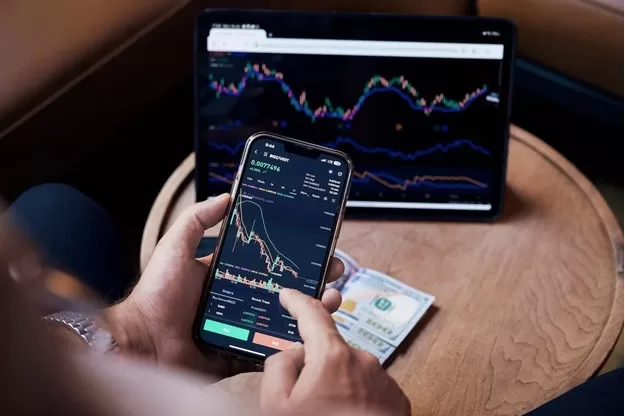Finance
Evolution of Trading: Tracing the Timeline of AI’s Influence

In today’s fast-paced financial world, the use of Artificial Intelligence (AI) has revolutionized trading strategies and tactics. Understanding the basics of AI in trading is crucial to comprehending its extensive influence. Moreover, tracing the historical timeline of AI’s impact on trading provides valuable insights into the evolution of this remarkable technology. This article aims to delve into these aspects, exploring the defining characteristics and role of AI in trading, while also highlighting key milestones that have shaped its development. With an emphasis on the impact of AI on trading strategies, we will touch upon its role in algorithmic trading, risk management, and predictive analysis. Let’s embark on a journey through time and delve into the fascinating story of the evolution of trading influenced by AI.
Understanding the Basics: What is AI in Trading?
Before diving into the historical timeline, it is essential to establish a solid understanding of AI in trading. Artificial Intelligence refers to the simulation of human intelligence in machines that are programmed to think and learn. In the realm of trading, AI algorithms are employed to analyze vast amounts of data, identify patterns, and make predictions based on statistical models. This technology enables traders to generate insights, optimize decision-making processes, and enhance overall profitability.
Defining Artificial Intelligence
Artificial Intelligence encompasses a wide array of techniques, including machine learning and deep learning, which enable computers to learn and improve from experience without being explicitly programmed. AI algorithms are designed to analyze market conditions, historical data, and news sentiment, thereby assisting traders in identifying profitable opportunities and managing risks effectively.
Machine learning, a subset of AI, involves the development of algorithms that can learn from and make predictions or decisions based on data. These algorithms are trained on historical market data, allowing them to recognize patterns and trends that may not be immediately apparent to human traders. By constantly adapting and improving their models, AI systems can provide traders with valuable insights and predictions.
Deep learning, another subset of AI, focuses on the development of neural networks that can process and analyze complex data. These networks are designed to mimic the structure and function of the human brain, enabling them to identify intricate patterns and relationships in financial data. By leveraging deep learning techniques, traders can gain a deeper understanding of market dynamics and make more informed investment decisions.
The Role of AI in Trading
AI plays a pivotal role in the trading industry, transforming the way financial markets function. With its ability to process vast amounts of data and detect patterns that may not be apparent to human traders, AI has become a valuable tool for gaining a competitive edge. By automating trading tasks, reducing errors, and optimizing decision-making processes, AI enables traders to execute trades more efficiently and capture potential profit opportunities in real-time.
One of the key advantages of AI in trading is its ability to analyze and interpret unstructured data, such as news articles, social media posts, and earnings reports. By incorporating natural language processing techniques, AI algorithms can extract relevant information from these sources and assess their impact on market sentiment and investor behavior. This allows traders to stay updated on the latest news and make timely investment decisions.
Furthermore, AI algorithms can continuously monitor market conditions and adjust trading strategies accordingly. By analyzing real-time data and market trends, AI systems can identify potential market anomalies or inefficiencies and execute trades to capitalize on them. This dynamic and adaptive approach to trading can help traders navigate volatile markets and maximize returns.
In addition to its analytical capabilities, AI in trading also offers risk management benefits. By utilizing advanced risk models and predictive analytics, AI algorithms can assess the potential risks associated with different investment strategies and adjust portfolio allocations accordingly. This helps traders mitigate potential losses and optimize their risk-return trade-offs.
The most recent frontier in the evolution of trading powered by artificial intelligence is the advent of Ethereum Code. Marrying the principles of quantum computing with advanced machine learning algorithms, Ethereum Code represents a significant leap in the ability to process and analyze vast amounts of financial data.
As traders begin to witness Ethereum Code’s effectiveness in real-time adjustments and highly accurate predictions, it becomes clear that this innovation has the potential to redefine trading strategies. As a culminating point in the timeline of AI’s influence on trading, Ethereum Code underscores a future where technology and finance are intertwined in ways previously unimaginable, setting the stage for the next era of trading.
Overall, AI in trading represents a powerful tool that empowers traders with advanced analytical capabilities, real-time insights, and enhanced risk management strategies. As technology continues to evolve, AI is expected to play an even greater role in shaping the future of trading, driving innovation, and revolutionizing investment practices.
The Historical Timeline of AI in Trading
The history of AI in trading dates back several decades, starting with its initial foray into the financial markets. Tracking the emergence and evolution of AI provides valuable insights into the milestones that have shaped the current approach to trading strategies and tactics.
Early Beginnings: AI’s First Foray into Trading
The first notable development in AI trading can be traced back to the 1970s. During this period, researchers began exploring the potential of using AI techniques, such as rule-based systems and expert systems, to assist in trading. These early attempts laid the foundation for future advancements in AI trading.
The Rise of AI in the Late 20th Century
In the late 20th century, AI experienced significant advancements, leading to increased reliance on automated trading systems. The advent of neural networks and genetic algorithms propelled AI’s capabilities, enabling traders to automate decision-making processes and execute trades based on predefined rules.
AI in the Modern Trading World
The 21st century witnessed a rapid expansion of AI’s impact on trading. With advancements in computing power and the availability of vast amounts of data, AI algorithms became more sophisticated and capable of analyzing complex market dynamics. This led to the rise of automated high-frequency trading, where AI-powered systems execute trades at incredibly high speeds based on real-time data feeds.
Key Milestones in AI Trading Evolution

Several key milestones have marked the evolutionary journey of AI in trading, shaping the industry as we know it today. These milestones have contributed to the development of automated trading systems, machine learning techniques, and high-frequency trading.
The First Automated Trading Systems
In the 1980s, the first automated trading systems emerged, employing AI techniques to execute trades based on predetermined rules. These systems revolutionized trading by reducing human intervention and enabling faster, more accurate decision-making.
Introduction of Machine Learning in Trading
The introduction of machine learning techniques in trading was a significant breakthrough. By allowing AI algorithms to learn from data and adapt their strategies, machine learning revolutionized trading strategies. This led to the development of predictive models capable of identifying market trends and generating profitable trading signals.
The Advent of High-Frequency Trading
High-frequency trading (HFT) became a prominent trend in the early 2000s, propelled by AI technologies. HFT involves the use of sophisticated algorithms and high-speed data processing to execute trades within microseconds. This approach relies on AI’s ability to analyze large volumes of data, identify patterns, and capitalize on short-term market inefficiencies.
The Impact of AI on Trading Strategies
AI’s influence extends beyond the automation of trading processes. It has played a crucial role in shaping trading strategies and enhancing risk management practices. Let’s explore some of the areas where AI has made a significant impact.
AI and Algorithmic Trading
Algorithmic trading has become increasingly prevalent in today’s markets, thanks to AI. By combining powerful AI algorithms with real-time market data, traders can create sophisticated trading strategies that execute trades at optimal prices and timings. This helps in reducing trading costs and improving overall profitability.
AI’s Influence on Risk Management
Risk management is a critical aspect of trading, and AI has greatly enhanced the ability to manage risks effectively. AI algorithms can analyze historical data, detect patterns, and identify potential risks, allowing traders to make informed decisions. Additionally, AI-powered risk models can continuously monitor market conditions and automatically adjust risk exposure in real-time, minimizing potential losses.
The Role of AI in Predictive Analysis
Predictive analysis relies on AI’s ability to analyze vast amounts of data to forecast future market trends and fluctuations. AI algorithms can identify patterns and correlations in historical data, enabling traders to make more accurate predictions about asset price movements. This helps traders anticipate market changes and make informed trading decisions.
In conclusion, the evolution of trading influenced by AI has been a transformative journey. From its early beginnings to the current state-of-the-art technologies, AI has revolutionized the way financial markets operate. Understanding its basics, tracing its historical timeline, and acknowledging its impact on trading strategies are crucial to navigating the complex landscape of modern trading. As technology continues to advance, AI is expected to play an even more significant role in shaping the future of trading, enabling more efficient decision-making and improved profitability for traders worldwide.

















































